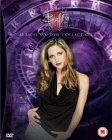 Buffy The Vampire Slayer - Season 4 | DVD | (06/03/2006)
from £17.99
| Saving you £17.00 (94.50%)
| RRP
Buffy The Vampire Slayer - Season 4 | DVD | (06/03/2006)
from £17.99
| Saving you £17.00 (94.50%)
| RRP Season Four sees Buffy Willow and Oz going to college at UC Sunnydale. Buffy immediately comes face-to-face with the leader of a gang of vampire thieves named Sunday. If that wasn't bad enough we learn that Buffy's roommate (who naturally has a Celine Dion poster) Kathy is a demon... Episodes Comprise: 1. The Freshman 2. Living Conditions 3. The Harsh Light Of Day 4. Fear Itself 5. Beer Bad 6. Wild At Heart 7. The Initiative 8. Pangs 9. Something Blue 10. Hush 11. Doomed 1
![Buffy The Vampire Slayer: Season 5 [DVD]](/pictures/1144665.jpg) Buffy The Vampire Slayer: Season 5 | DVD | (18/09/2017)
from £N/A
| Saving you £N/A (N/A%)
| RRP
Buffy The Vampire Slayer: Season 5 | DVD | (18/09/2017)
from £N/A
| Saving you £N/A (N/A%)
| RRP The fifth season of Joss Whedon's hit series started out in excellent form as slayer extraordinaire Buffy Summers (Sarah Michelle Gellar) did battle with the most famous of vampires (that Dracula guy) and then went on to spar with another nemesis, little sister Dawn (Michelle Trachtenberg). Wait--Buffy has a teenage sister? Where has she been the past four years? And why is everyone acting like she's always been around? Turns out that young Dawn is actually "The Key," a form of pure energy that, true to its name, helps open the gates between different dimensions. To protect said key from falling into the wrong hands, a group of monks gave it human form and sent it to the fiercely protective Buffy for safekeeping, creating new memories of Dawn for everyone as if she'd existed... well, always. Why all the super secrecy? There's this very, very, very bad girl named Glory (Clare Kramer) who wants the key very badly, and will do anything to get it. Oh, and by the way, Glory isn't just a run-of-the-mill demon... she's way worse. Some fans will tell you that Buffy "jumped the shark" with the introduction of Dawn, when in actuality this season was the pinnacle of the show's achievement, as there was superb comedy to be had ("Buffy Vs. Dracula," the double-Xander episode "The Replacement," the introduction of the "Buffybot" in "Intervention") as well as some of television's best drama. The Whedon-scripted and -directed "The Body" remains one of Buffy's best episodes, when the young woman who faces down supernatural death on a daily basis finds herself powerless in the wake of her mother's sudden passing. The first third or so of the season was a bit choppy, but once the evil Glory came into her own, Buffy was a television force to be reckoned with. Kramer was the show's best villain (after the evil Angel, natch), and the supporting cast was never better. But as always, it was the superb Gellar who was the powerful centre of the show, sparking opposite lovelorn vampire Spike (James Marsters) and wrestling with moral dilemmas rarely seen on television. With this season, Buffy Summers became, like Tony Soprano, one of television's true greats. --Mark Englehart
![Buffy The Vampire Slayer - Season 7 [2002]](/pictures/1039490.jpg) Buffy The Vampire Slayer - Season 7 | DVD | (08/05/2006)
from £24.98
| Saving you £10.01 (40.07%)
| RRP
Buffy The Vampire Slayer - Season 7 | DVD | (08/05/2006)
from £24.98
| Saving you £10.01 (40.07%)
| RRP The seventh and final season of Buffy's vampire vanquishing adventures. Episodes Comprise: 1. Lessons 2. Beneath You 3. Same Time Same Place 4. Help 5. Selfless 6. Him 7. Conversations With Dead People 8. Sleeper 9. Never Leave Me 10. Bring On The Night 11. Showtime 12. Potential 13. The Killer In Me 14. First Date 15. Get It Done 16. Storyteller 17. Lies My Parents Told Me 18. Dirty Girls 19. Empty Places 20. Touched 21. End Of Days 22. Chosen
 Buffy the Vampire Slayer: Season 6 DVD Collection | DVD | (18/10/2004)
from £29.98
| Saving you £50.01 (166.81%)
| RRP
Buffy the Vampire Slayer: Season 6 DVD Collection | DVD | (18/10/2004)
from £29.98
| Saving you £50.01 (166.81%)
| RRP The sixth series of Buffy the Vampire Slayer followed the logic of plot and character development into some gloomy places. The year begins with Buffy being raised from the dead by the friends who miss her, but who fail to understand that a sacrifice taken back is a sacrifice negated. Dragged out of what she believes to have been heavenly bliss, she finds herself "going through the motions" and entering into a relationship with the evil, besotted vampire Spike just to force her emotions. Willow becomes ever more caught up in the temptations of magic; Xander and Anya move towards marriage without ever discussing their reservations; Giles feels he is standing in the way of Buffy's adult independence; Dawn feels neglected. What none of them need is a menace that is, at this point, simply annoying--three high school contemporaries who have turned their hand to magical and high-tech villainy. Added to this is a hungry ghost, an invisibility ray, an amnesia spell and a song-and-dance demon (who acts as rationale for the incomparable musical episode "Once More With Feeling"). This is a year in which chickens come home to roost: everything from the villainy of the three geeks to Xander's doubts about marriage come to a head, often--as in the case of the impressive wedding episode--through wildly dark humour. The estrangement of the characters from each other--a well-observed portrait of what happens to college pals in their early 20s--comes to a shocking head with the death of a major character and that death's apocalyptic consequences. The series ends on a consoling note which it has, by that point and in spite of imperfections, entirely earned. --Roz Kaveney
 Las Vegas - Series 3 | DVD | (05/02/2007)
from £7.99
| Saving you £27.00 (337.92%)
| RRP
Las Vegas - Series 3 | DVD | (05/02/2007)
from £7.99
| Saving you £27.00 (337.92%)
| RRP Las Vegas one of the sexiest show on TV is back and even hotter on DVD in Season 3! Episodes Comprise: 1. Viva Las Vegas 2. Fake the Money and Run 3. Double Down Triple Threat 4. Whatever Happened to Seymour Magoon? 5. The Big Ed De-cline 6. The Real McCoy 7. Everything Old Is You Again 8. Bold Beautiful & Blue 9. Mothwoman 10. For Sail by Owner 11. Down and Dirty 12. Bait and Switch 13. The Bitch Is Back 14. And Here's Mike with the Weather 15. Urban Legend 16. Coyote Ugly 17. Lyle & Substance 18. Like a Virgin 19. Cash Springs Eternal 20. All Quiet on the Montecito Front 21. Chaos Theory 22. Fidelity Security Delivery 23. Father of the Bride
 Buffy the Vampire Slayer: Complete Season 3 | DVD | (18/10/2004)
from £28.69
| Saving you £51.30 (178.81%)
| RRP
Buffy the Vampire Slayer: Complete Season 3 | DVD | (18/10/2004)
from £28.69
| Saving you £51.30 (178.81%)
| RRP Action-packed Season Three develops major characters and plot lines brewing over the last couple of years. The Mayor, this season's major baddie, wants to become an invincible demon by slaughtering everyone at Sunnydale High's graduation ceremony but he's going to torture them all by giving his speech first. Bad-girl vampire-slayer Faith wants to get one over on Buffy and becomes even more rotten. Angel comes back from hell but isn't sure what to do about his girlfriend. Willow meets her evil gay vampire duplicate from another dimension. Xander loses his virginity but still has to contemplate his essential uselessness. Cordelia gets less whiny and has to work in a dress-shop when her father becomes bankrupt. Giles wears tweed and drinks tea, though it is revealed that he used to be a warlock and in a punk band. Besides the soap opera, there are monsters, curses and vampires (inevitably). --Kim Newman On the DVD: The DVDs are presented in a standard television 4:3 picture ratio and in a clear Dolby sound that does full justice both to the sparkling dialogue and to the always impressive indie-rock and orchestral scores. Special features include an overview of Season Three by its creator Joss Whedon, and by writers Marti Noxon, David Fury, Doug Petrie and Jane Espenson and documentaries on the weapons, clothes special effects of the show and the speech/verbal tone which makes it what it is-"Buffyspeak". The episodes "Helpless", "Bad Girls", "Consequences" and "Earshot" have commentaries by, Fury, Petrie, director James Gershman and Espenson, in which we find out some fascinating details about the way the scripts mutate and about the particular illuminations added to scripts by actors' performances. After complaints about the Season 2 DVD packaging, the disc envelopes include a protective coating. --Roz Kaveney
 Buffy the Vampire Slayer: Complete Season 2 | DVD | (18/10/2004)
from £N/A
| Saving you £N/A (N/A%)
| RRP
Buffy the Vampire Slayer: Complete Season 2 | DVD | (18/10/2004)
from £N/A
| Saving you £N/A (N/A%)
| RRP After the first season of Buffy The Vampire Slayer became a ratings success the show was renewed with a bigger budget and twice as many episodes. Seeds are sown through the early episodes for many of the stunning plot developments later in the season: there's a slow burn for the relationships building between Buffy and Angel (no surprise), Giles and Jenny (nice surprise), and Xander and Cordelia (huge surprise). Most importantly, we're introduced to important semi-regulars Spike and Drusilla ("School Hard"), Oz ("Inca Mummy Girl") and fellow Slayer Kendra ("What's My Line Part 1"). Their appearances tackle youth issues such as sibling rivalry, sexual maturity and rejection. But nothing that came before it prepared audiences for the latter half of season 2. In the extraordinary double act of "Surprise" and "Innocence" every aspect of the show grows up in a big hurry: the result of Buffy sleeping with Angel is a series of tragedies everyone is powerless to predict or prevent, a piece of powerful storytelling conveyed with pared-down dialogue and remarkable performances from the young cast. All of these threads are tied together then torn apart by the two-part finale "Becoming". With a cliffhanger ending to rival The Empire Strikes Back, the second chapter of Buffy The Vampire Slayer closes in tantalising style leaving everything at stake. --Paul Tonks On the DVD: The computer-animated menu opens this gorgeous box set in style with a tour through a dark and oppressive cemetery, a lavish display of graphics that's all the more impressive when compared to the uneventful DVD for the first season. Most of the extra features are concentrated on the last disc, which includes the obligatory biographies, trailers and TV spots that add little value to hardcore fans but serve as a good introduction to the world of Buffy for non-adepts. The three featurettes are captivating: "Designing Buffy" offers a wealth of information about the set designs, and even includes a walk through of Buffy's home; "A Buffy Bestiary" features every monster from the second season, and "Beauty and the Beats" explores the make-up artistry and special effects. There are also brief cast interviews, in which James Masters ("Spike") reveals his American accent. All in all the extras make a worthy accompaniment to the spectacular season 2 episodes, though one might regret that Joss Whedon did not offer a commentary on the double bill season finale "Becoming". --Celine Martig
 Buffy the Vampire Slayer: Complete Season 5 | DVD | (18/10/2004)
from £N/A
| Saving you £N/A (N/A%)
| RRP
Buffy the Vampire Slayer: Complete Season 5 | DVD | (18/10/2004)
from £N/A
| Saving you £N/A (N/A%)
| RRP The fifth season of Buffy the Vampire Slayer is about illusions and the truth that they often reveal; suddenly Buffy has a younger sister, has always had a younger sister. Michelle Trachtenberg as the moody, gawky Dawn achieves the considerable triumph of walking into an established stock company of well-known characters--Xander, Willow, Giles and so on--with the perfect assurance of a long-term member of the cast. Of course, nothing is as it seems; even Glory, the mad brain-sucking beauty in a red dress who is the villain of the year, turns out to be even more than she seems. Sarah Michelle Gellar as Buffy manages to convey heartbreak, self-involvement and real heroism as her relationship with her emotionally dense soldier boyfriend Riley hits the shoals and the blonde vampire Spike starts to show an altogether inappropriate interest. This season is also about the hard truth that there are some enemies it is impossible to fight. Even being around Buffy and Dawn is dangerous for their friends, as Glory and her minions proceed by a process of elimination. The eventual confrontation, when it comes, is genuinely shocking. Meanwhile, the vampire Spike's obsessed desire for Buffy takes them both to some very strange places and Willow and Tara have their love tested in the most gruelling of ways. And in the quietly upsetting episode "The Body", the cast produce their most impressive performances yet as they have to deal with another enemy they cannot fight. --Roz Kaveney
![Buffy Season 4 [DVD] [2017]](/pictures/1144689.jpg) Buffy Season 4 | DVD | (18/09/2017)
from £N/A
| Saving you £N/A (N/A%)
| RRP
Buffy Season 4 | DVD | (18/09/2017)
from £N/A
| Saving you £N/A (N/A%)
| RRP In its fourth season, Buffy the Vampire Slayer had to change its formula radically. Two major characters--the vampire-with-a-soul Angel and Cordelia, the queen bitch of Sunnydale High--had gone off to be in their own show, Angel, and soon after the start of the season Willow's werewolf boyfriend Oz left when Seth Green needed to concentrate on his film career. Buffy and Willow started college, where they met new characters like Riley, the All-American Boy with a double life, and Tara, the sweet stuttering witch; but Xander and Giles found themselves at something of a loose end. Several characters were subjected to the radical re-envisioning possible in a show that deals with the supernatural: the blond vampire Spike came back and soon found himself with an inhibitor chip in his head, forced into reluctant alliance with Buffy; the former vengeance demon Anya became passionately smitten with Xander. Not all fans were happy with the central story arc about the sinister Dr Walsh (Lindsay Crouse) and her Frankensteinian creation Adam, though Crouse's performance was memorable. The strength of Season Four was perhaps most in impressive stand-alone episodes like the silent "Hush", the multiple dream sequence "Restless" and the passionate, moving "New Moon Rising", in which Oz returns, apparently cured, only to find that Willow is no longer waiting for him. This was one of the high points of the show as a vehicle for intense acting, perhaps only equalled by "Who Are You?", in which the evil slayer Faith takes over Buffy's body and Sarah Michelle Gellar gets to play bad girl for once. --Roz KaveneyOn the DVD: Buffy Season 4 was a hit and so is this sublime box set. The commentaries for "The Initiative", "This Year'sGirl", "Superstar" and "Primaveral" are all well above average, but are nothing compared to "Hush" and "Restless" where Joss Whedon gives out all the information and insights any fan would dream of. The four featurettes included are a pleasure to watch, especially the evolution of the sets for the show. The scripts, trailers and cast biographies complete the set and make for a decent addition to your Buffy archive. The soundtrack is in 2.0 Dolby surround, but the image is as grainy and dark as the previous seasons on DVD. --Celine Martig
![Buffy the Vampire Slayer: The Slayer Collection (Cordelia) [1998]](/pictures/1021500.jpg) Buffy the Vampire Slayer: The Slayer Collection (Cordelia) | DVD | (01/11/2004)
from £5.99
| Saving you £7.00 (116.86%)
| RRP
Buffy the Vampire Slayer: The Slayer Collection (Cordelia) | DVD | (01/11/2004)
from £5.99
| Saving you £7.00 (116.86%)
| RRP The best episodes from the 'Buffy The Vampire Slayer' series featuring fashion-conscious Cordelia...
 Buffy the Vampire Slayer: The Slayer Collection (Xander) | DVD | (01/11/2004)
from £8.91
| Saving you £4.08 (45.79%)
| RRP
Buffy the Vampire Slayer: The Slayer Collection (Xander) | DVD | (01/11/2004)
from £8.91
| Saving you £4.08 (45.79%)
| RRP The best episodes from the 'Buffy The Vampire Slayer' TV series featuring the wisecracking Xander (Nicholas Brendon)...
![Buffy The Vampire Slayer: Season 6 [DVD]](/pictures/1144679.jpg) Buffy The Vampire Slayer: Season 6 | DVD | (18/09/2017)
from £N/A
| Saving you £N/A (N/A%)
| RRP
Buffy The Vampire Slayer: Season 6 | DVD | (18/09/2017)
from £N/A
| Saving you £N/A (N/A%)
| RRP The sixth series of Buffy the Vampire Slayer followed the logic of plot and character development into some gloomy places. The year begins with Buffy being raised from the dead by the friends who miss her, but who fail to understand that a sacrifice taken back is a sacrifice negated. Dragged out of what she believes to have been heavenly bliss, she finds herself "going through the motions" and entering into a relationship with the evil, besotted vampire Spike just to force her emotions. Willow becomes ever more caught up in the temptations of magic; Xander and Anya move towards marriage without ever discussing their reservations; Giles feels he is standing in the way of Buffy's adult independence; Dawn feels neglected. What none of them need is a menace that is, at this point, simply annoying--three high school contemporaries who have turned their hand to magical and high-tech villainy. Added to this is a hungry ghost, an invisibility ray, an amnesia spell and a song-and-dance demon (who acts as rationale for the incomparable musical episode "Once More With Feeling"). This is a year in which chickens come home to roost: everything from the villainy of the three geeks to Xander's doubts about marriage come to a head, often--as in the case of the impressive wedding episode--through wildly dark humour. The estrangement of the characters from each other--a well-observed portrait of what happens to college pals in their early 20s--comes to a shocking head with the death of a major character and that death's apocalyptic consequences. The series ends on a consoling note which it has, by that point and in spite of imperfections, entirely earned. --Roz Kaveney
![Buffy The Vampire Slayer: Season 7 [DVD] [2017]](/pictures/1144690.jpg) Buffy The Vampire Slayer: Season 7 | DVD | (18/09/2017)
from £11.49
| Saving you £N/A (N/A%)
| RRP
Buffy The Vampire Slayer: Season 7 | DVD | (18/09/2017)
from £11.49
| Saving you £N/A (N/A%)
| RRP The seventh and final season of Buffy the Vampire Slayer begins with a mystery: someone is murdering teenage girls all over the world and something is trying hard to drive Spike mad. Buffy is considerably more cheerful in these episodes than we have seen her during the previous year as she trains Dawn and gets a job as student counselor at the newly rebuilt Sunnydale High. Willow is recovering from the magical addiction which almost led her to destroy the world, but all is not yet well with her, or with Anya, who has returned to being a Vengeance demon in "Same Time, Same Place" and "Selfless," and both women are haunted by their decisions. Haunting of a different kind comes in the excellent "Conversations with Dead People" (one of the show's most terrifying episodes ever), in which a mysterious song is making Spike kill again in spite of his soul and his chip. Giles turns up in "Bring on the Night" and Buffy has to fight one of the deadliest vampires of her career in "Showtime". In "Potential" Dawn faces a fundamental reassessment of her purpose in life. Buffy was always a show about female empowerment, but it was also a show about how ordinary people can decide to make a difference alongside people who are special. And it was also a show about people making up for past errors and crimes. So, for example, we have the excellent episodes "Storyteller", in which the former geek/supervillain Andrew sorts out his redemption while making a video diary about life with Buffy; and "Lies My Parents Told Me," in which we find out why a particular folk song sends Spike crazy. Redemption abounds as Faith returns to Sunnydale and the friends she once betrayed, and Willow finds herself turning into the man she flayed. Above all, this was always Buffy's show: Sarah Michelle Gellar does extraordinary work here both as Buffy and as her ultimate shadow, the First Evil, who takes her face to mock her. This is a fine ending to one of television's most remarkable shows. --Roz Kaveney

Please wait. Loading...
This site uses cookies.
More details in our privacy policy